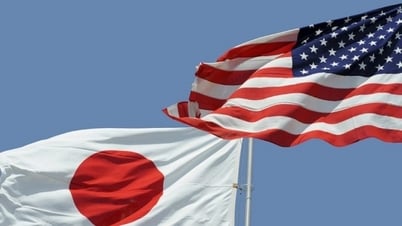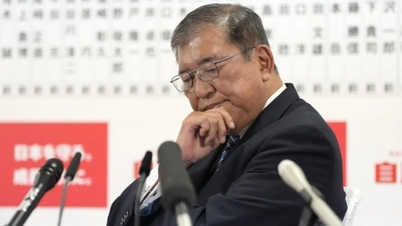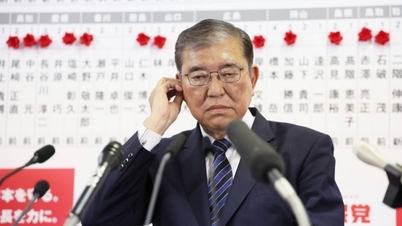(CLO) For the first time since 2009, the ruling Liberal Democratic Party (LDP) lost its majority in the Japanese House of Representatives after a heavy defeat in the October 27 election. The defeat will cause Prime Minister Shigeru Ishiba to face many challenges and the Japanese political situation will inevitably be impacted and affected.
Mr. Ishiba's "wrong move"
According to the election results, the LDP suffered a historic defeat in the general election on October 27. Even with the support of the Komeito Party, which has been in coalition with the LDP for a quarter of a century, the election results could not help the ruling party and Prime Minister Shigeru Ishiba maintain a majority in the 465 seats in the Lower House.
There are many explanations for the ruling LDP's failure stemming from the party elite's money laundering scandal that was exposed in late 2021. However, it cannot be denied that the Japanese people's growing dissatisfaction with the government's socio -economic policies, which have led to a significant decline in the living standards of the vast majority of Japanese, has seriously damaged the LDP's reputation, forcing Fumio Kishida - Shigeru Ishiba's predecessor - to resign and not run for re-election as party leader.

Did Japanese Prime Minister Shigeru Ishiba miscalculate? Photo: Reuters
After being elected Prime Minister, Shigeru Ishiba quickly dissolved the House of Representatives and called for early elections. Analysts believe that Mr. Ishiba wanted to capitalize on his high personal ratings by portraying himself as a clean politician and narrow the opportunities for opposition forces that could not unite in a short period of time.
However, Prime Minister Shigeru Ishiba’s calculations were completely wrong because he underestimated the level of dissatisfaction with the ruling party. As a result, his strategy of holding early lower house elections backfired. The defeat was also a disaster for the Komeito party, which was embroiled in a scandal that cost its new leader, Keiichi Ishii, his seat in parliament.
Although the defeat of the ruling LDP does not mean that there will be a change in senior personnel in the government, in order to implement his policies and guidelines, Prime Minister Shigeru Ishiba will have to build a new ruling coalition with the opposition party. Many opinions say that it could be the People's Democratic Party, but this party has too many differences with the ruling LDP, and it will be extremely difficult to form such a coalition before the next parliamentary session, scheduled to take place on November 11.
Risk of political instability
A heavy defeat for the ruling LDP in early lower house elections will plunge the country's politics into uncertainty and make it difficult for Prime Minister Shigeru Ishiba to pursue reforms needed to regain voter support.
Mr. Ishiba once pledged to first minimize the negative impact of inflation on households, strengthen Japan's security and defense against "security threats" to the country in the Northeast Asia region, solve the problem of declining birth rates, increase birth rates, ensure economic stability and strengthen the country's ability to cope with natural disasters...
Apparently, Prime Minister Shigeru Ishiba has become more realistic, abandoning some of his previous commitments, such as reducing dependence on nuclear energy in favor of renewable energy, establishing an “Asian NATO,” revising the US-Japan security treaty toward equality, and many other issues.
These proposals will certainly raise questions and objections not only from Japan’s Asian neighbors but also from its key ally, the United States. However, Washington has assured Tokyo that the United States will continue to cooperate with Japan as a close ally on security challenges in the Indo-Pacific region, global issues and especially promoting trilateral cooperation between the United States, Japan and South Korea.
Will the military buildup policy be difficult?
In the context of the nuclear issue on the Korean Peninsula "heating up", it is not surprising that Prime Minister Shigeru Ishiba will continue the path of his predecessor Kishida, not only strengthening military cooperation with Washington and Seoul, but also promoting military modernization with the expectation of bringing Japan's military spending to 2% of GDP by 2027, which is at the average level of NATO countries.
The national security strategy adopted under former Prime Minister Fumio Kishida gives the Japanese military offensive capabilities, a departure from the post-World War II constitution, which places restrictions on the Self-Defense Forces (SDF), which are only used for the purpose of defending Japanese territory.
The new security strategy will not only provide Tokyo with long-range weapons such as the US-made Tomahawk missile, but also actively develop its own long-range missiles that can strike bases from which potential adversaries can attack Japanese territory. In addition, Prime Minister Shigeru Ishia will continue to strengthen cooperation with NATO, promote the implementation of the “Quad” framework (Japan - US - Australia - India) as well as other multilateral and bilateral cooperation.
However, the defeat of the ruling LDP will make it difficult for Prime Minister Shigeru Ishiba to push forward his tough stance on security and defense issues. Ishiba has always supported the modernization of the SDF and the country's more active participation in international military activities.
Experts say that Mr. Ishiba’s proactive deterrence stance is likely to face fierce opposition from the opposition party, as it goes against the “defense” stance in the country’s constitution. Overall, it is currently difficult to predict what Prime Minister Shigeru Ishiba will be able to implement from his plan in the current unstable internal political situation in Japan.
Ha Anh
Source: https://www.congluan.vn/nhung-thach-thuc-cho-nhat-ban-sau-that-bai-lich-su-cua-dang-cam-quyen-post319251.html



![[Photo] President of the Cuban National Assembly visits President Ho Chi Minh's Mausoleum](https://vphoto.vietnam.vn/thumb/1200x675/vietnam/resource/IMAGE/2025/10/1/39f1142310fc4dae9e3de4fcc9ac2ed0)


![[Photo] Hanoi morning of October 1: Prolonged flooding, people wade to work](https://vphoto.vietnam.vn/thumb/1200x675/vietnam/resource/IMAGE/2025/10/1/189be28938e3493fa26b2938efa2059e)




























































































Comment (0)